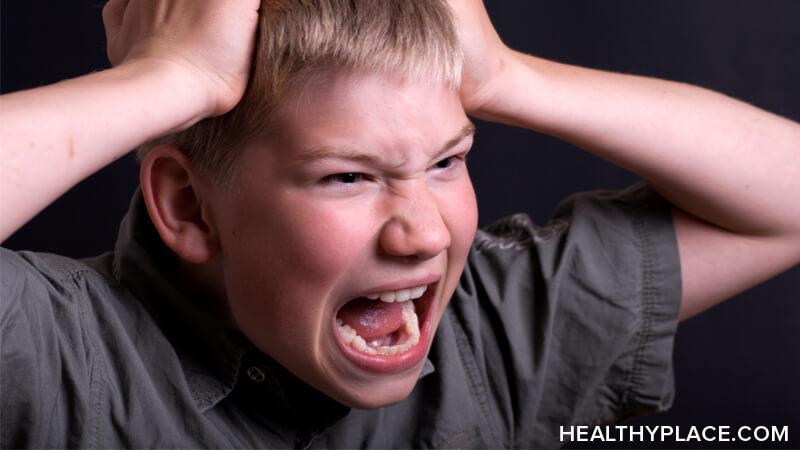When Your Child with Mental Illness Requires Restraints

The use of restraints for children with mental illness in hospitals and schools is common and legal.1 While instances of abuse and overuse do happen and should be taken very seriously, this post isn't meant to debate whether restraints should be eliminated in the treatment of mental illness.2 Neither is it meant to promote the use of restraints. Instead, this is a look at how my own family has experienced them.
The Stigma of Restraints for Mental Illness
Because it's Halloween, I'll address a stigma first. When people think "restraints" and mental illness, they think padded rooms and straight jackets. The imagery associated with these things are especially common around Halloween. This association is incorrect and stigmatizing.
Straight jackets were discontinued a long time ago.3 Seclusion rooms exist, but they are not "padded rooms." Joking about these things scares people away from mental health treatment. It also minimizes experiences of mental illness to ugly stereotypes. So be kind and readjust how you refer to people with mental illness and institutions that treat mental illness, even those that use restraints ("Psychiatric Hospitalization: What I Wish I'd Known").
Restraints for Children with Mental Illness in Hospitals
If psychiatrically hospitalized, a child has been determined a danger to themselves or others. Being a danger does not require restraints for mental illness treatment, though. From my experience as a mental health professional, hospitalization alone is typically the method for managing safety concerns, and a person is eventually discharged to the community when safe to do so. Restraints are rarely required.
My son spent most of his two-week hospitalization wandering the unit freely, taking part in treatment. When he got violent, staff removed others from the area and helped de-escalate the situation. He didn't require restraints.
When he first went into the ER, though, he was out of control. He threw things in the ER, kicked and punched, or tried to harm himself. Staff attempted de-escalation techniques, but he started ripping things off walls and finding dangerous objects and hurting himself.
They resorted to a four-point restraint on a gurney. They strapped him down, tying down each arm and each leg. He then required chemical restraints because he kept screaming for hours. Chemical restraints are usually injections of sedating medications, and hospitals don't take them lightly.4
Restraints for Children with Mental Illness in School
My son has been restrained at school as well. In most parts of the U.S, it is legal to use physical restraints in schools. If your child is on an individualized education plan (IEP), they may have a behavior intervention plan (BIP). Behavior intervention plans start with simple accommodations in the classroom and walk through additional techniques as behaviors worsen. The last steps might be restraints but not necessarily ("Special Education Rights and Responsibilities").
My son had a tough transition to middle school this year and, one day, he just exploded. He had an outburst that anybody with a child with disruptive mood dysregulation disorder (DMDD) would understand immediately as dangerous but others may not truly comprehend until they see it. Staff tried a sensory room for de-escalation, but he started self-harming. Three grownups had to hold him down to stop him.
The Trauma of Using Restraints for a Child with Mental Illness
My son's ER experience was obviously horrible. It was horrible for me to watch and horrible for him to experience. The school restraints were hard for him, too, and the staff was exhausted. In both instances, though, a balancing act was at play. We had to balance whether to use restraints or allow him to seriously harm himself or end his life.
Knowing this doesn't erase the trauma, of course, but it helps me manage it. Planning ahead helps, too. Talk to the schools. Talk to mental health providers. Involve yourselves in the first steps of intervening when things get hard. The ultimate hope is that your child with mental illness will never need restraints because the staff is well-trained, your child's behaviors are well-understood, and other techniques work.
Sources
- U.S. Department of Education (2012). Restraint and Seclusion: Resource Document. Retrieved on October 30, 2018.
- Substance Abuse and Mental Health Services Administration (2015). Alternatives to Seclusion and Restraint. Retrieved on October 20, 2018.
- Susaman, David (2018). 7 Myths About Physical Restraints in Psychiatric Facilities. Retrieved on October 30, 2018.
- Sorrentino, A (2004). Chemical restraints for the agitated, violent, or psychotic pediatric patient in the emergency department: Controversies and recommendations. Retrieved on October 30, 2018.
APA Reference
David, M.
(2018, October 31). When Your Child with Mental Illness Requires Restraints, HealthyPlace. Retrieved
on 2025, November 14 from https://www.healthyplace.com/blogs/parentingchildwithmentalillness/2018/10/when-your-child-with-mental-illness-requires-restraints